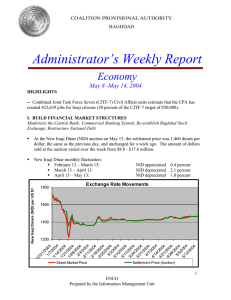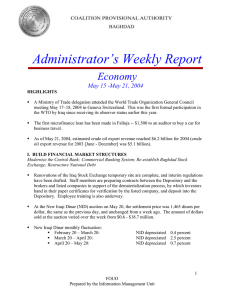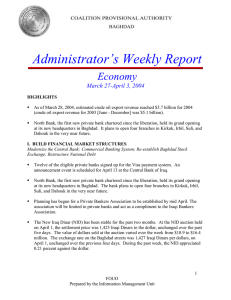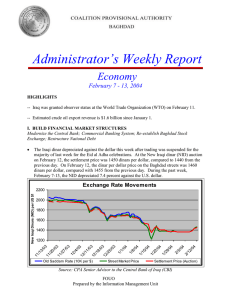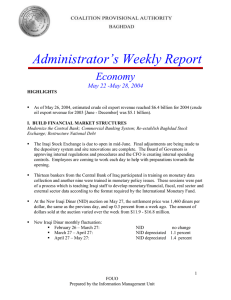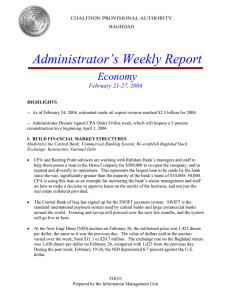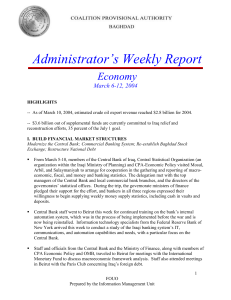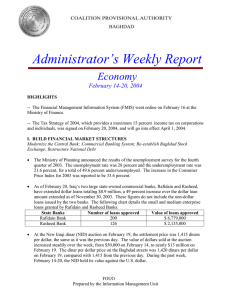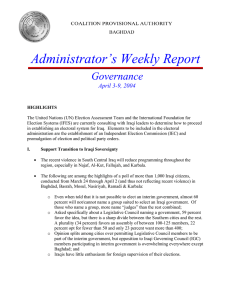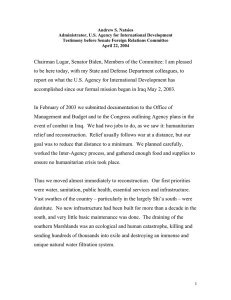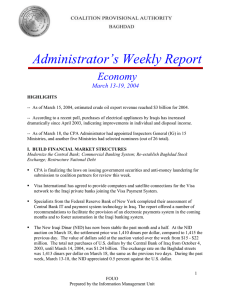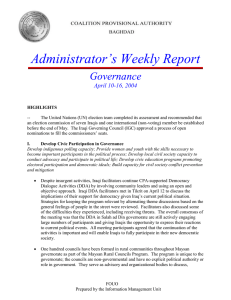Administrator’s Weekly Report Economy March 20-26, 2004
advertisement
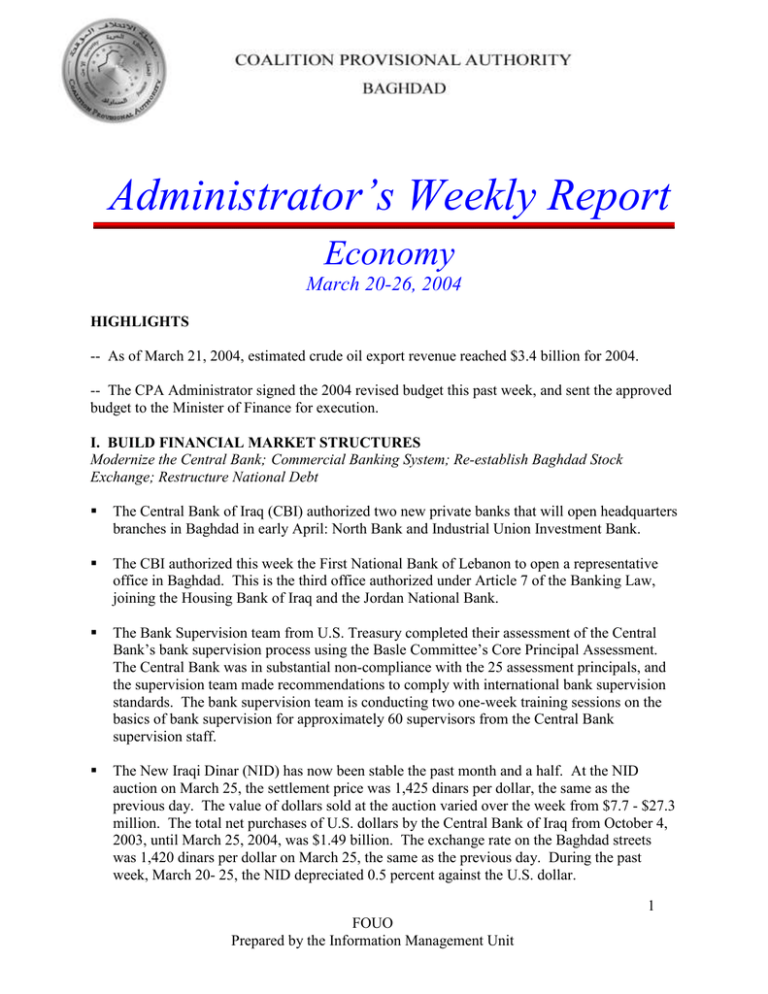
Administrator’s Weekly Report Economy March 20-26, 2004 HIGHLIGHTS -- As of March 21, 2004, estimated crude oil export revenue reached $3.4 billion for 2004. -- The CPA Administrator signed the 2004 revised budget this past week, and sent the approved budget to the Minister of Finance for execution. I. BUILD FINANCIAL MARKET STRUCTURES Modernize the Central Bank; Commercial Banking System; Re-establish Baghdad Stock Exchange; Restructure National Debt The Central Bank of Iraq (CBI) authorized two new private banks that will open headquarters branches in Baghdad in early April: North Bank and Industrial Union Investment Bank. The CBI authorized this week the First National Bank of Lebanon to open a representative office in Baghdad. This is the third office authorized under Article 7 of the Banking Law, joining the Housing Bank of Iraq and the Jordan National Bank. The Bank Supervision team from U.S. Treasury completed their assessment of the Central Bank’s bank supervision process using the Basle Committee’s Core Principal Assessment. The Central Bank was in substantial non-compliance with the 25 assessment principals, and the supervision team made recommendations to comply with international bank supervision standards. The bank supervision team is conducting two one-week training sessions on the basics of bank supervision for approximately 60 supervisors from the Central Bank supervision staff. The New Iraqi Dinar (NID) has now been stable the past month and a half. At the NID auction on March 25, the settlement price was 1,425 dinars per dollar, the same as the previous day. The value of dollars sold at the auction varied over the week from $7.7 - $27.3 million. The total net purchases of U.S. dollars by the Central Bank of Iraq from October 4, 2003, until March 25, 2004, was $1.49 billion. The exchange rate on the Baghdad streets was 1,420 dinars per dollar on March 25, the same as the previous day. During the past week, March 20- 25, the NID depreciated 0.5 percent against the U.S. dollar. 1 FOUO Prepared by the Information Management Unit New Iraqi Dinar monthly fluctuation: December 26 – January 25: January 26 – February 25: February 26 – March 25: NID appreciated 18.4 percent NID depreciated 4.4 percent NID appreciated 0.7 percent Exchange Rate Movements New Iraqi Dinars (NID) per US $1 12 /2 5/ 20 03 1/ 1/ 20 04 1/ 8/ 20 04 1/ 15 /2 00 4 1/ 22 /2 00 4 1/ 29 /2 00 4 2/ 5/ 20 04 2/ 12 /2 00 4 2/ 19 /2 00 4 2/ 26 /2 00 4 3/ 4/ 20 04 3/ 11 /2 00 4 3/ 18 /2 00 4 3/ 25 /2 00 4 2000 1800 1600 1400 1200 Old Saddam Rate (10K per $) Street Market Price Settlement Price (Auction) Source: CPA Senior Advisor to the Central Bank of Iraq Annualized Weekly Volatility of the NID 80.00% 70.00% 60.00% 50.00% 40.00% 30.00% 20.00% 10.00% 12 /2 5/ 20 03 1/ 1/ 20 04 1/ 8/ 20 04 1/ 15 /2 00 4 1/ 22 /2 00 4 1/ 29 /2 00 4 2/ 5/ 20 04 2/ 12 /2 00 4 2/ 19 /2 00 4 2/ 26 /2 00 4 3/ 4/ 20 04 3/ 11 /2 00 4 3/ 18 /2 00 4 3/ 25 /2 00 4 0.00% Settlement Price NID Volatility Street Market Price NID Volatility Source: CPA Senior Advisor to the Central Bank of Iraq The annualized weekly volatility of the new Iraqi dinar this past week was 1.1 percent. The following chart shows the month/month change in Consumer Price Index (CPI) from January – February 2004 by category. The Iraqi Central Statistical Office (CSO) in the Ministry of Planning and Development Cooperation conducts the surveys and calculates the CPI. The CPI is not seasonally adjusted, but CPA advisors are working with the CSO to include this type of analysis. The average month-to-month percentage change in the CPI from August 2003 – February 2004, was 3.7 percent. The month-to-month percentage change in the CPI from January – February 2004, was -5.3 percent. Inflation has actually decreased the past two months, confirming some recent polls showing that people believe FOUO Prepared by the Information Management Unit 2 prices had decreased from January to February. The weighting for the CPI is based on information gathered in the 1997 census. The CSO will update the CPI weighting after conducting a new census. February 2004 CPI: Month/Month Non-Seasonally Adjusted Change -8.0% Food Cigarettes / alcohol -1.4% -4.6% Clothing Overall CPI Change: - 5.3% -3.2% Furniture -17.1% Fuels / electricity Transport and communications -2.6% 1.6% Medical -2.3% Service s 0.0% Rent -20.0% -15.0% -10.0% -5.0% 0.0% 5.0% Source: Iraqi Central Statistical Office The following chart shows the year/year change in the CPI, from February 2003 – February 2004 by category. The CPI increased by 27.9 percent over the course of a year. While an annual inflation of this magnitude is rather high, for comparison, the average annual percentage change in the CPI from 1991- 2002 was 115 percent. In post-conflict situations, and compared to Iraq’s recent history, this inflation rate is much better than expected. February 2004 CPI: Year/Year Change 160% 141.3% 60% 40% 37.9% 36.1% 18.3% 20% 9.9% Cigarettes / alcohol 80% Overall CPI Change: + 27.9% Clothing 100% Furniture 120% Transport and communications 140% 18.8% -12.1% -7.5% Food Fuels / electricity -40% Medical -20% Services 0% Rent -39.7% -60% Source: Iraqi Central Statistical Office FOUO Prepared by the Information Management Unit 3 The Iraq stock exchange continues to plan for an April opening. The Iraqi Governing Council is reviewing the securities law. II. DEVELOP TRANSPARENT BUDGETING AND ACCOUNTING ARRANGEMENTS Redrafting and Execution of 2004 Budget The CPA Administrator signed the 2004 revised budget this past week, and sent the approved budget to the Minister of Finance for execution. The revised budget totals are $19.927 billion, an increase of $6.51 billion (48 percent) over the initial 2004 budget. Moving from the 4-tier to the 11-tier civil salary scale and hazardous duty payments increased expenditure by $480 million, and required fuel imports increased the budget by $2.1 billion, among other expenditure increases. In the finalized budget, salaries account for 12.7 percent of the budget, the Facilities Protection Service receives 0.3 percent, capital costs are 12.7 percent, and the operating costs (not including salaries) represent 74.3 percent of the budget. The estimated revenue for the 2004 budget is $14.486 billion, consisting primarily of $14.2 billion in projected oil revenues. The reconstruction levy and other minor taxes provide the balance of the estimated revenue. The $5.41 billion of uncommitted funds remaining in the DFI account on December 31, 2003 ($4.4 billion greater than projections in October 2003), and transferred assets from abroad ($200 million) will finance the budget deficit, resulting in ending financial capital worth $170 million. As of March 25, the balance in the Development Fund for Iraq (DFI) was $7.3 billion, comprised of $6.3 billion in the original Federal Reserve Bank of New York (FRBNY) account, and $1 billion on deposit in DFI-Baghdad. Of this, $4.1 billion is already committed to projects, and the remaining $3.2 billion is slated for projected 2004 budget items. Since establishment, the DFI investment program at FRBNY earned $17 million in interest. As of March 25, the total payments out of the DFI amounted to $7 billion. State Department and U.S. Agency for International Development (USAID) assistance to Iraq disbursed in FY 2003/2004 totals $3.2 billion as of March 26, 2004: USAID/ Asia and Near East (ANE): USAID/ Office of Foreign Disaster Assistance (OFDA): USAID/ Food for Peace (FFP): USAID/ Office of Transition Initiatives (OTI): State Department/ Bureau of Population, Refugees, and Migration (PRM): $2.6 billion $101 million $426 million $104 million $39 million The Program Management Office (PMO) intends to commit $10.4 billion (56 percent of the $18.4 billion supplemental) toward contracts by July 1, 2004. As of last week, $4 billion are currently committed to Iraq relief and reconstruction efforts, 39 percent of the July 1 goal. As of last week, $2.1 billion of funds are obligated with contractors (20 percent of the FOUO Prepared by the Information Management Unit 4 committed fund’s goal). The following chart shows the money committed by sector against the July 1 target as of March 24. PMO: Supplemental Money Committed by July 1 6000 5000 Millions of Dollars 4000 3000 2000 1000 0 Oil Electricity Security Water Transport/ Telecom ED & Human Rights Roads/ Bridges Private Sector Justice & Public Safety Health Care Democracy 2207 Report 1701 5560 3243 4332 500 280 370 184 1018 793 458 July 1 Target 1701 2079 3057 861 601 618 4 131 540 325 458 Updated Apportionment Mar 24 1600 1708 2483 496 165 203 119 70 526 330 458 Total Committed March 24 904.9 1402.7 1143 31.9 137.2 31.6 4 0.2 145.7 0 204.8 Source: Program Management Office Section 2207 of the Emergency Supplemental Appropriations Act for Defense and for the Reconstruction of Iraq and Afghanistan, FY 2004 (Public Law 108-106) enumerates the allotments granted to CPA for each sector and levies a quarterly reporting requirement to Congress detailing PMO’s spending. III. PRIVATE SECTOR INITIATIVES Streamline existing commercial code/regulations; Facilitate lending to private businesses; Technical Assistance for Small and Medium Enterprises (SMEs); Iraqi Participation in Reconstruction Subcontracts; Business Development The Minister of Trade signed all instructions for the different types of corporate registration (foreign branches, domestic companies, domestic companies founded by foreigners), effective immediately. CPA will assist the Ministry of Trade with the implementation of new systems and hardware at the registrar. CPA continues to follow-up with companies that participated in the foreign investment road show in Europe. Insurance is a major concern for potential investors, and CPA is working to FOUO Prepared by the Information Management Unit 5 understand insurance options for companies who are interested in investing here. CPA is updating the investor packet to reflect any new information. IV. DESIGN OIL TRUST FUND Proposal for Oil Trust Fund As of March 21, 2004, estimated crude oil export revenue reached $3.4 billion for 2004 (crude oil export revenue for 2003 [June - December] was $5.1 billion). V. LAY FOUNDATIONS FOR AN OPEN ECONOMY Provide IG Staff Capability; Trade Bank; WTO Observer Status; Draft Intellectual Property law to IGC by April 15, 2004; Develop Framework for Collateralizing Movable and Immovable Property As of March 24, the Trade Bank of Iraq has issued 123 letters of credit, totaling $516.3 million, covering imports from 24 countries. An additional 36 letters of credit are pending, including one letter of credit that will be guaranteed by the Export-Import Bank of the United States and 13 Oil for Food letters of credit. VI. PURSUE NATIONAL STRATEGY FOR HUMAN RESOURCES DEVELOPMENT Begin to employ workers in Public Works programs around the country The Ministry of Labor and Social Affairs (MoLSA) operates 17 employment centers nationwide. MoLSA is on target to have 28 centers nationwide open by June 30. The Baghdad employment center registered 2,171 new job seekers this week, bringing the total registered job seekers for Baghdad to 51,303. The Baghdad employment center also placed 326 unemployed people in permanent jobs this week. MoLSA is beginning to collect data on registered job seekers for all of its employment centers, and will report this in the coming weeks. Combined Joint Task Force 7 (CJTF-7) Civil Affairs units estimate that the CPA has created 394,717 jobs for Iraqi citizens (46 percent of the CJTF-7 target of 850,000): Security/National Defense employs Regional Jobs Programs employ CJTF-7 employs Civilian contractors working under CPA contracts employ Governorate Teams employ 229,665 42,521 51,673 69,308 1,550 VII. INITIATE PUBLIC SECTOR MANAGEMENT REFORM Civil Service Salary Review As of March 27, the CPA Administrator had appointed Inspectors General (IG) in 18 Ministries, and another five Ministries had selected nominees (out of 26 total). Almost all Ministries are expected to have IGs appointed by the end of March. FOUO Prepared by the Information Management Unit 6
